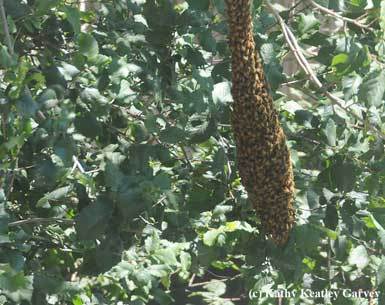Bee Rescuers
Do you have a swarm of bees near to or on your property? Do you wonder what these bees are up to? The bees are just looking for a home. Swarming is a natural part of the honey bee life cycle. Bees are very important members of our ecosystem, and they are vital to agricultural, so we want to promote their populations – but bees aren't much help to farmers and beekeepers when they have made a home in a roof or on a utility pole.
Bee Ready
If you would like to talk with someone about relocating the bees or have discovered that bees have built a nest in an unwanted location, such as inside a wall, in the rafters or inside a chimney, the beekeepers on this list have agreed to help you relocate them. There is no set fee structure. Many beekeepers will remove a swarm of bees at no or little charge; some will ask for a donation or a minimum reimbursement to assist with their fuel costs. If the bees are located at a site where more elaborate equipment is needed to reach them, or enclosed in walls or other structures, you can expect a fee. Some beekeepers are licensed contractors and some work with contractors. You may need to have your own contractor repair the wall or any structural components damaged in the removal process.
Please be prepared with the following information before contacting one of the Bee Rescuers:
Swarm of bees on branch

- Are you positive they are honey bees? Please look at the common Buzz Library photo gallery for help.
- How far above the ground are the bees located? What is the cluster hanging on?
- How long have the bees been there?
- How large is the cluster? The size of a baseball, a grapefruit or a basketball?
- If possible, take a phone photo and text it to the beekeeper contact for your county.
- Are you the owner of the property where the bees are located? If not, do you have the phone contact of the owner?
- Is location easily accessible; is there drive-up access?
Find a Bee Rescuer in Your County
The list of beekeepers and beekeeping groups below can be used as a reference to find a Bee Rescuers near you. We strive to update this information and keep it as current as possible. If for some reason a contact is no longer active, please call the local beekeeping organization in your county or Agricultural Commissioner. Thanks for looking out for the bees.
California Bee Rescuers
List of CA Bee RescuersFlorida Bee Rescuers
List of FL Bee RescuersMontana Bee Rescuers
List of MT Bee RescuersOntario (Canada) Bee Rescuers
List of Ontario Bee RescuersSouth Dakota Bee Rescuers
List of SD Bee RescuersTexas Bee Rescuers
List of TX Bee RescuersOther states:
Visit beeswarmed.org for more information, to report a swarm directly, or to sign up as a beekeeper.
Bee Rescuing 101
Please be sure they are honey bees and not wasps
Many beekeepers head out to collect a swarm only to find that the insects are wasps. Callers who are unsure about the correct identification should submit a photo to the beekeeper. Supply as much information as possible--location, accessibility, size and height—to prevent surprises.
Do not attempt to remove a swarm of honey bees yourself
In most cases, a honey bee swarm does not pose a threat to people, pets or buildings. They are not defending their colony but are on the move for a new home. If the swarm is in clear view or within the height of a ladder, an experienced beekeeper can collect a swarm within a short period of time.
Please do not spray the cluster or kill them
Swarming is the way honey bees reproduce. Do not kill them; we want to try to rescue and relocate them. Unfortunately, the honey bee population has dwindled over the past decades. Honey bees not only pollinate our crops, but they also pollinate a wide variety of plants that support other wildlife. Only the strongest and healthiest of colonies produce swarms. Destroying them destroys the good genes.
The bees are vulnerable
When honey bees swarm, they cluster or “hang out” on a branch, a roof overhang or some other structure that offers some protection. They are very vulnerable. The “swarm” is a collection of young and older bees and usually one queen. The queen is unable to fly far due to her comparatively short wings. While they are clinging together, the “scout bees” are out searching for a new home for the colony. Once that new location is identified and selected, the bees will fly off to establish their new home. Often a swarm will leave before you even notice it’s there!
Africanized Bees
While we consider honey bees sacred; not all honey bees make good neighbors. Africanized bees are most often too defensive (sting too much) to be good neighbors. As such, it not advised to capture swarms nor remove wild hives from trees or buildings in an area known to have Africanized bees. The public has a very positive image of bees and the pollination they provide and the pure honey they produce. Please don't diminish this good public image of honey bees by encouraging Africanized bees. These bees are easy to distinguish based on how readily they sting and will follow you once disturbed.
Africanized bees are present in parts of the Southern United States, including Texas, Florida, Arizona, New Mexico, and California. In California Africanized bees have been confirmed in the following counties: Mariposa, Madera, Kings, Inyo, Tulare, San Luis Obispo, Kern, Santa Barbara, San Bernardino, Ventura, Los Angeles, Orange, Riverside, San Diego, and Imperial. If you live in any of these counties there is a chance that you may encounter a swarm of Africanized bees.
Sponsors

Support for California Bee Rescuers has been provided by founding Business for Bees member Pacific Gas and Electric Company (PG&E) as part of their commitment to environmental stewardship and conservation. Quite often bee swarms end up on utility poles or other utility infrastructure. PG&E's policy is to humanely remove and relocate honey bees whenever possible.
Support for Bee Rescuers is provided by the United States Department of Agriculture People's Garden Initiative.